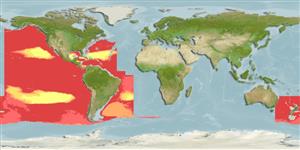>
Lophiiformes (Anglerfishes) >
Gigantactinidae (Whipnose anglers)
Etymology: Gigantactis: Greek, 'gigas' or 'gigantos' = gigantic + Greek, 'aktis' = ray (referring to the unusually long first dorsal-fin spine that functions as a lure in this genus) (Ref. 86949).
More on author: Regan.
Environment: milieu / climate zone / depth range / distribution range
Ecología
marino batipelágico; rango de profundidad 650 - 2500 m (Ref. 86949). Deep-water
Atlantic Ocean and Pacific Ocean.
Tamaño / Peso / Age
Maturity: Lm ? range ? - ? cm
Max length : 11.7 cm SL macho / no sexado; (Ref. 13608); 35.4 cm SL (female)
Espinas dorsales (total): 0; Radios blandos dorsales (total): 5-6; Espinas anales 0; Radios blandos anales: 5 - 6. Metamorphosed females distinguished by the following characteristics: length of illicium 340-447% SL; escal bulb with lightly pigmented truncated distal prolongation; 6-20 long distal filaments; escal papillae absent; proximal escal papillae absent; short dentary teeth (longest 1.3-3.4% SL, average 2.3% SL), arranged posteriorly in two longitudinal series; length of caudal fin rays less than 45% SL; weakly developed skin coverage of proximal part of caudal fin; caudal fin rays free nearly to base (Ref. 86949).
Appear to be active predators which feed on midwater fishes, including Cyclothone acclinidens, Triphoturus mexicanus and Bathylagus stilbius; cephalopods like Vampyroteuthis; and various invertebrates like amphipods, natant decapod crustaceans and coelenterates (Ref. 4525). Maximum length for female from Ref. 41361.
Life cycle and mating behavior
Madurez | Reproducción | Puesta | Huevos | Fecundidad | Larva
Uyeno, T., K. Matsuura and E. Fujii (eds.), 1983. Fishes trawled off Suriname and French Guiana. Japan Marine Fishery Resource Research Center, Tokyo, Japan. 519 p. (Ref. 13608)
IUCN Red List Status (Ref. 130435)
Threat to humans
Harmless
Human uses
Más información
Nombres comunesSinónimosMetabolismoDespredadoresEcotoxicologíaReproducciónMadurezPuestaAgregación para la puestaFecundidadHuevosEgg development
ReferenciasAcuiculturaPerfil de acuiculturaRazasGenéticaElectrophoresesheritabilidadEnfermedadesProcesamientoNutrientsMass conversion
ColaboradoresImágenesStamps, Coins Misc.SonidosCiguateraVelocidadTipo de nataciónSuperficie branquialOtolitosCerebrosVisión
Herramientas
Special reports
Download XML
Fuentes de Internet
Estimates based on models
Preferred temperature (Ref.
123201): 2.4 - 5.6, mean 4.3 °C (based on 372 cells).
Phylogenetic diversity index (Ref.
82804): PD
50 = 0.5000 [Uniqueness, from 0.5 = low to 2.0 = high].
Bayesian length-weight: a=0.01995 (0.00906 - 0.04395), b=3.01 (2.83 - 3.19), in cm total length, based on all LWR estimates for this body shape (Ref.
93245).
Nivel trófico (Ref.
69278): 4.0 ±0.61 se; based on food items.
Fishing Vulnerability (Ref.
59153): Low to moderate vulnerability (33 of 100).
